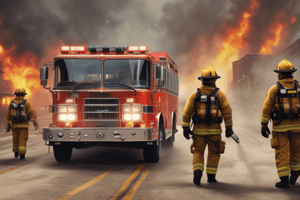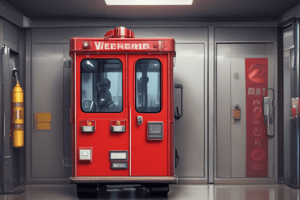Podcast
Questions and Answers
What is the primary purpose of a backup line?
What is the primary purpose of a backup line?
- To protect the egress of crews operating within a structure (correct)
- To help suppress the fire
- To serve as a secondary means of attack
- To provide extra water volume to the initial line
What should be the minimum length of a backup line compared to the initial line?
What should be the minimum length of a backup line compared to the initial line?
- Two lengths longer than the initial line
- One length shorter than the initial line
- One length longer than the initial line (correct)
- The same length as the initial line
What is the main difference between a backup line and a second line?
What is the main difference between a backup line and a second line?
- The material used to make the hose
- The flow rate of the water
- The purpose of the line (protection vs. suppression) (correct)
- The color of the hose
Why should a backup line have the same flow rate as the initial line?
Why should a backup line have the same flow rate as the initial line?
What is the importance of clear communication on the fireground when calling for additional hose lines?
What is the importance of clear communication on the fireground when calling for additional hose lines?
What should not be done with the terms 'backup line' and 'second line'?
What should not be done with the terms 'backup line' and 'second line'?
Flashcards are hidden until you start studying
Study Notes
Fireground Operations
- Multiple hose lines may be required to control a fire
Backup Line
- A hose line stretched at every fire to protect the egress of crews operating within a structure
- Should be at least one length longer than the initial line it is protecting
- Should have the same flow or greater than the initial line
- Purpose: to prevent fire growth if the initial line is stretched short of the seat of the fire, and to provide additional volume of water if needed
Second Line
- A hose line needed to help suppress the fire, rather than protect egress of the initial line
- Distinguished from a backup line, which prioritizes egress protection
Communication on the Fireground
- Clear communication is crucial when calling for additional hose lines to suppress the fire or protect egress
- The terms "backup line" and "second line" should not be used interchangeably to avoid confusion among firefighters
Studying That Suits You
Use AI to generate personalized quizzes and flashcards to suit your learning preferences.



